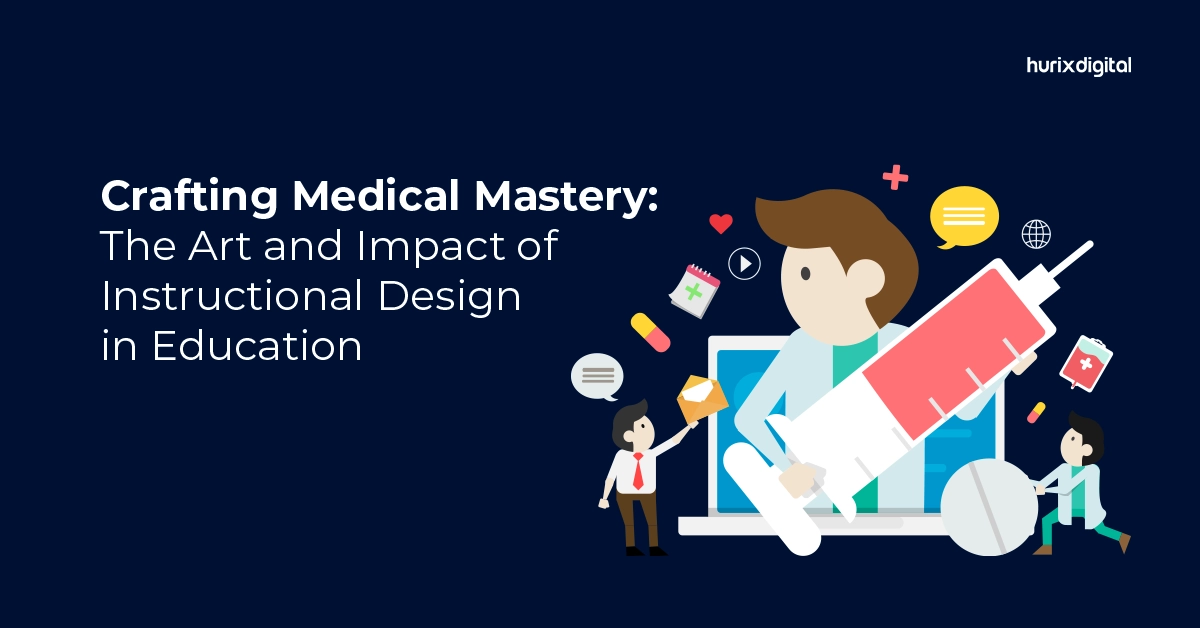
Crafting Medical Mastery: The Art and Impact of Instructional Design in Education
The way that education and training are translated into prompt, on-the-spot patient care makes the medical field incredibly unique. Apprentice nurses, clinical interns, affiliated healthcare professionals, chemists, and graduate doctors are the ones who interact with patients daily and contribute significantly to the profession.
When creating courses, medical instructors frequently run the risk of giving casual, fragmented instruction. For this reason, one of the most dependable and effective methods of medical professional education is the Instructional design methodology.
This blog outlines the various benefits, impacts, and intricacies of medical higher education instructional design. Let’s dive in!
Table of Contents:
- What is Higher Education Instructional Design?
- Effective Instructional Design for Medical Education
- Benefits of Instructional Design for Medical Education
- Takeaway
What is Higher Education Instructional Design?
The area of knowledge known as instructional design links instructional theory to instructional practice by recommending actions to maximize student achievement. While developing content and evaluations are common tasks for educators, the methodical planning of instruction involves various steps.
These steps are required to guarantee the creation of outstanding educational experiences, from determining the requirement for instruction to the last stage of ensuring whether the intended learning has taken place. The components of an instructional design are unified, outcome-based, and connected methodically to guarantee that the key components of learning are aligned.
Systematic higher education instructional design takes into account all facets of the teaching and learning process, including objectives, student requirements and skills, the educational setting, resources at hand, and desired efficiency to come up with tests, instructional strategies, and additional content.
Also Read: Innovative Education Solutions the Healthcare Industry Can Make Use of in 2024
Effective Instructional Design for Medical Education
In medical education, the primary goals of instructional design are to enhance learning, facilitate retention of information, and foster skill development. Medical instructors can get help from instructional design models, like the Gagné models, in creating engaging lesson plans.
The most popular phases of medical education instructional design & production are:
1. Analysis
This stage entails a meticulous examination of the training participants’ requirements. According to the operational theory, the program will change depending on the requirements of the various learners and the roles and tasks they are anticipated to complete.
2. Development
In this stage, the performance objectives and learning outcomes for the educational activities are described in detail.
Establishing well-defined objectives will facilitate the creation of an excellent curriculum that guides both teachers and students.
3. Design
Using the knowledge gained from the previous two phases, the Design phase entails creating targeted events, projects, and lessons while considering learning outcomes to meet the goals. The choice of the instruction medium is made at this stage as well.
It is crucial to evaluate the curriculum at this point to make sure it is reliable and helpful for the medical professionals for whom it is intended.
4. Implementation
In this stage, the curriculum is put into practice and given to the group receiving training. It is imperative to have a strategy for execution because a poorly executed instructional design program can potentially undermine even the most well-thought-out initiative.
5. Evaluation
This is the second of two phases in which the assessment is conducted in a way that goes beyond focusing only on the student’s learning outcomes. It also assesses the effectiveness of the instructional program and how well it adheres to the established learning objectives. This allows the program to be reorganized based on what functions well and what needs to be eliminated.
Benefits of Instructional Design for Medical Education
The way that medical students and other healthcare professionals learn is greatly influenced by instructional design. Institutions can improve student engagement and the acquisition of skills in medical education by implementing instructional design principles into designing curricula.
Here are the top 5 benefits of higher education instructional design in the realm of healthcare:
1. Personalized Learning Experiences
The ability to create individualized learning experiences that cater to each student’s unique needs and learning preferences is one of the main advantages of instructional design in medical education.
Students’ retention and comprehension of difficult medical concepts are enhanced by this individualized approach, which guarantees that the material they are given is pertinent, interesting, and easily understandable.
2. Aims at Creating Interactive Learning Experiences
Dynamic simulations, case studies, virtual patient scenarios, and gamified instruction are frequently employed in medical education to foster critical thinking, problem-solving, and decision-making skills.
Teachers can improve the ability of learners to put their theoretical knowledge in practical settings by integrating interactive components into the curriculum. This involves students participating in significant educational tasks that mimic real-world clinical scenarios. This is made easier using simulations and other technologies that can replicate real-world scenarios for students to gain hands-on experience.
3. Multimodal Learning Resources
The use of multimodal learning resources is encouraged in medical education instructional design to fit varying learning styles and preferences.
Teachers can make the educational content more engaging by combining the text with various interactive elements like graphics, audio files, and videos. Through repetition, visualization, and interaction, this range of multimedia resources increases engagement and solidifies learning, resulting in a deeper comprehension of difficult medical concepts.
4. Provides Assessment and Feedback Mechanisms
Assessing student progress, identifying areas for growth, and providing timely feedback to enhance learning outcomes are all made possible by effective instructional design. This is achieved by incorporating assessment and feedback mechanisms into the learning process.
In medical education, quizzes, case-based evaluations, peer reviews, and formative assessments are frequently used to track student progress, encourage self-evaluation, and guarantee the growth of skills. Teachers can monitor student progress, spot learning gaps, and effectively modify instruction to meet every pupil’s requirements by integrating these assessment tools into the instructional design.
5. Encourages Lifelong Learning
Through promoting self-directed learning, and reflective practice, instructional design in medical education promotes a culture of lifelong learning among healthcare professionals.
Instructional designers can enable students to stay up to date on medical advancements, and continuously improve their skills throughout their careers with the use of problem-based learning approaches.
Also Read: The Role of Virtual Simulations in Healthcare Education
Takeaway
The instructional design approach for medical professionals places more of a focus on how students learn than how teachers impart knowledge. Given that healthcare workers will utilize newly acquired skills for the entire span of their careers in the medical field, curriculum planning becomes even more crucial.
A well-crafted program will motivate medical students to put their existing and fresh skills to the tasks at hand. This will act as an organized curriculum providing medical professionals with outstanding learning experiences.
If you are looking for higher education instructional design solutions, get in touch with Hurix Digital. We assist you in converting your standard class periods into engaging educational opportunities. From the beginning, our online learning programs are in line with your academic objectives. Contact us for more information today!

Senior Vice President – Business Development
Over 25 years of experience in the edtech and workforce learning industry with strong skills in Business Development, Customer Relationship Management (CRM) and Strategy.





